The 5 Best Classic Electric Guitars That Every Recording Studio Should Have
Electric guitars first started making their way into the music industry in the 1930s, and have been a staple of American popular music ever since.
Thousands of different models have been manufactured over the years, making it no small task for studio owners and recording guitarists to decide which models are truly essential for their collection.
Today, we break down a list of some of the most important electric guitars that you may want to have handy in the studio —as well as when and why you might want to reach for each of them.
For the purpose of this article, we are focusing on “classic” guitars that offer some truly iconic tones. These are the primary colors of the producer’s palette.
We’ll also provide our top recommendations for specific models that can help you round out your studio collection, no matter what the price. So without further ado, let’s dive right in!
(PS—Did we miss any of your favorites? Tell us about it in the comments below, and you might just find your recommendation in a follow up story on some fantastic and flexible alternatives to these icons of recorded music.)
1. Fender Stratocaster
The Stratocaster, designed by Leo Fender, is about as classic as they come.
In the studio, a Strat is a fantastic tool, with 3 pickups and a 5-way selector to switch between them, allowing you to toggle between the bright, surf-rock chime of its bridge pickup, the bluesy growl of its middle pickup, the mellow chunkiness of its neck pickup, or the smooth and scooped sound of its two in-between positions, which are wired in reverse parallel to reduce hum.
Fender has released countless iterations of the Strat over the years, but the truly classic Strat sound comes from an ash or alder body and a maple or rosewood fingerboard on a maple neck.
Alder is a very balanced tone wood where lows, mids, and highs resonate fairly equally, and is probably the most common body choice for Strats.
When it comes to ash, you’ll find two types: less commonly, northern “hard ash” (a dense, heavy tone wood that Fender used more often in the 1970s, lending some of the guitars of the era a brighter tone) and the more popular “swamp ash”, which tends to be lighter and more porous. This quality helps give Strats made from swamp ash sound both clear and warm, for a tone that is perhaps even more “hi-fi” tone than either alder or hard ash making this choice a perennial favorite for the studio.
The two most common fingerboard woods you will encounter on Strats are rosewood and maple. A rosewood fingerboard adds a lot of warmth to the guitar, whereas a maple fingerboard can a bit of extra brightness and clarity to a Strat (sometimes almost excessively so.)
I tend to prefer maple fretboards on a Strat for the studio, not only because it looks better to my eye, but because it adds some extra articulation and brightness to each note, requiring less EQ to help it fit it into a mix, and making funky guitar parts pop off the neck.
For clean guitar parts, especially funky ones, or for Texas-style distorted riffs in the style of Stevie Ray Vaughan, a Strat is a go to studio instrument. It’s also a natural choice for surf rock, certain flavors of blues, and for gritty, fuzzed-out classic rock leads.
If you want articulation, and the ability to hear clear note definition within chords or single-note passages, consider using a Strat on your next session.
Famous Users:
The Edge – U2
The Edge of U2 is known for playing many guitars but when it comes to his quintessential guitar tone, “Where The Streets Have No Name” is often the first song that comes to mind. That delayed, jangly, unmistakably Strat-y sound drives the song.
Nile Rodgers
Perhaps the funkiest guitar player alive, Nile Rodgers has been making hits with artists such as Chic, David Bowie, Robert Plant, Daft Punk and Pharrell Williams. His main guitar, humbly dubbed “The Hitmaker,” shows that an old 1960 Strat can still groove—and even excel—when it comes to funky strumming and staccato melodies, even in modern day pop:
Ritchie Blackmore
Of course, Strats can also rock, and do it well, with some distortion applied. Deep Purple’s “Smoke on the Water” was performed on a Stratocaster and, while gritty, you can also hear some twang from the guitar adding to the flavor of this iconic riff.
Recommended Models:
Good: Squier Classic Vibe Stratocaster ($399) of Fender Mexican Standard Stratocaster ($599)
Fender’s “Squier” label puts out what is easily my favorite sub-$500 Strat. The “Classic Vibe” models tend to be quite consistent in quality and they play great thanks to their comfortable glossed 60’s style maple necks.
Personally, I dislike the gloss on the back of the neck as it can feel sticky during long studio sessions and make it hard to slide around the neck. Still, as this guitar is relatively cheap, you can take some light grain sandpaper and take away a lot of the gloss without feeling guilty.
With either the Squier or Mexican-made Standard Strats, you can freely experiment with changing the pickups and hardware if you like, such as upgrading the tuners or trying a different style bridge and still have a great (heavily customized) guitar for way under $1000.
Better: Fender American Standard Stratocaster $1,000 and up
The Fender American Standard is the obvious choice for a studio that needs a professional quality Strat without breaking the bank. Though even better options exist for not much more money, no one is ever going to fault you for having an American Standard lying around to round out your studio’s toolbox.
Consider an upgrade to the American Select, which features hotter, “overwound” pickups, or the Deluxe model, which adds in noiseless pickups and “S1” switching that activates serial wiring for higher-gain, humbucker-esque tones.
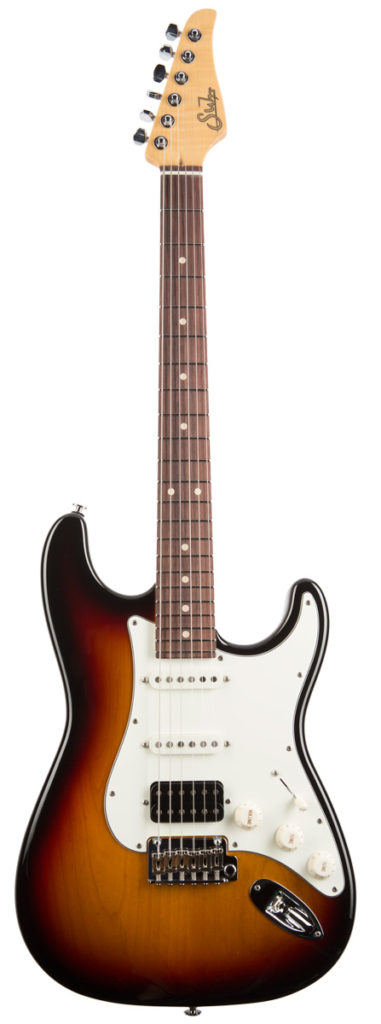
Swapping out the surfy-soudning bridge pickup of a Fender Strat for a humbucker, as pictured with this Suhr Classic Pro can get you extra grit and power instead of “chime”.
Best: Suhr Classic Pro ($1995) or Rust Guitars by Matt Brewster [30th Street Guitars] – ($2,295)
The Suhr Classic Pro seems to be a more versatile, better-playing, and more faithful emulation of a classic Strat sound, even though it’s not made by Fender.
The first thing that struck me about the guitar was its SSCII passive 60 cycle hum reduction system that seemed amazingly quiet. Suhr also uses a really thin finish on these guitars to allow the wood to resonate even more.
The locking tuners and Gotoh tremolo bridge ensure tuning stability and the V70 pickups capture the punch of the low strings and the sizzle of the high strings. The stainless steel frets are amazingly smooth and pretty, and as they make the guitar brighter, I would recommend a rosewood fingerboard if you want to get a Suhr Classic Pro. This is a fantastic studio instrument that will make you want to play guitar more often.
Matt Brewster at 30th Street Guitars makes some of my favorite guitars in terms of playability, sound, and looks. He uses nitrocellulose finishes and can relic a Rust Guitar for you so that you spend less time worrying about scratching it or denting it, and more time playing the damn guitar!
He tends to use really big 50s style necks that feel incredibly fast and that contribute a lot of low end and directivity to the sound coming out of the guitar.
The Lollar pickups are incredibly honest, capturing every nuance of your guitar playing and of the incredibly vibrant instrument itself. The 6100 fretwire is sanded down quite flat ensuring great intonation all the way up the neck.
2. Fender Telecaster
Descended from the single-pickup “Fender Esquire”, the Telecaster became the first successfully mass-produced guitar, shortly after it was released by Leo Fender toward the start of the 1950s.
It was also the first commercially available solid-body guitar, made from a block of wood, with the cavities drilled into the guitar body using a router. Before this, guitar bodies were largely hollow and carved by hand.
The Telecaster is a sleek and simple design consisting of two single coil pickups, usually a maple neck, and either an ash or alder body. It traditionally sports a single volume knob, a tone knob, and a three way pickup selector.
This basic design hasn’t changed too drastically over the years, though many rock and metal players such as John 5 [Rob Zombie], Jim Root [Slipknot and Stone Sour] and Chris Shiflett [Foo Fighters] do prefer a dual humbucker version of the Tele for added beef and gain—not to mention the ability to cut single coil 60 cycle hum out of their high-gain rigs.
The two most popular takes on the Tele design are the original “Broadcaster”-style design and the ’72 Telecaster Deluxe which is a bit of a cross between a Les Paul and a Tele, due to its dual humbucker design three-way pickup selector and individual volume and tone knobs for each pickup.
A classic Tele is always a great guitar to have in your tone arsenal. The bridge can deliver an unmistakably country twang or a gritty “quack”, and the neck offers a smoother, mellower, and more elegant jazz-like tone than anything you can easily coax out of a Strat. Meanwhile, the Deluxe version of a Tele offers all the power of a Les Paul, but with a level of clarity and note separation that just screams “Fender”.
If you already have a Strat, but love the snap, sparkle and clean articulation of the Fender line you might want to consider the Tele or Tele Deluxe as a more separate flavor of guitar for your studio.
The classic tonewoods for a Telecaster are also ash and alder for the body and maple or rosewood fingerboards with a maple neck just like most Strats.
Famous Users:
Bruce Springsteen
Bruce Springsteen would just look incredibly strange if he weren’t holding his butterscotch Telecaster on stage. He wouldn’t sound quite the same either.
Jimmy Page (Led Zeppelin)
Jimmy Page is known for playing Les Pauls on stage, but he used a Telecaster a lot back when he was primarily a session guitarist, as well as on some classic Led Zeppelin recordings like “Communication Breakdown” and “How Many More Times.” The latter really shows the potential of a distorted Tele to replace or augment a horn section on a recording, as it can sound harsh and bright without being brittle or annoying.
Recommended Models:
Good: Squier Classic Vibe Tele ($399) or Fender Mexican Standard Telecaster ($599)
The Squier Classic Vibe series kills it once again. These Teles are great for the price, just like their Strat counterparts. Truly great instruments at a reasonable price = happy guitarists. (And studio owners.)
Better: Fender Road Worn 50’s Tele ($899) or ’52 Reissue ($1999)
To call the Road Worn Series of guitars “great” workhorse guitars would be an understatement. I love everything about this series of guitars, from the smooth satin feel of the neck to the light nitrocellulose finishes that allow the wood to breathe and resonate freely.
The Road Worn guitars from Fender are some of the most comfortable I have ever played—and they look great too! If you don’t like the relic’d look of these guitars, you might consider the more expensive and ever-popular ’52 reissue model, but if you’re like me and don’t care, you will spend many hours exploring all of the tonal options yearning to be played out of these fantastic guitars.
Best: Rust Guitars or Fender Custom Shop Tele (approx. $2290 – $9,120)
Once again, Matt Brewster at Rust Guitars is making some of the best Fender-style guitars I have ever played and his aren’t disastrously expensive—especially compared to some of the offerings from the Fender Custom Shop.
Still, I love some of Fender Custom Shop work, especially by master builder John Cruz. If you see any of his Teles, make sure to stop whatever it is you’re doing and try one out!
Also worth exploring are Tele copies from Fano, Schecter, ESP, and the LSL T-Bone.
3. Gibson Les Paul
Completing the trifecta of essential studio guitars is arguably the most iconic guitar in history, the Gibson Les Paul.
From Les Paul himself to Ace Frehley, Jimmy Page to Bob Marley, Duane Allman to Zakk Wylde, Pete Townshend to Slash, (even Eric Clapton and Jeff Beck at times) the Les Paul has shown its versatility time and time again.
The solid body Les Paul was first produced in 1952 but didn’t become popular until 1960.
In terms of sound, expect a lot of sustain and fullness blossoming out of the instrument. The classic mahogany neck and body with a maple top of a Les Paul create a rich, warm tone, and also make Les Pauls notoriously heavy—normally weighing between 7 and 10lbs.
This might be cumbersome if the guitarist is standing while playing during a long session, but most of the time it isn’t a problem. Occasionally, you will find even darker sounding Les Paul Customs, that are made entirely of mahogany, with no maple top to help add some “bite” to their tone.
If you are playing rock, you can never go wrong with a Les Paul Standard. For years, a Les Paul and a Marshall amplifier defined the sound of rock music. This was the classic combo of guitar and amp for players like Slash, Zakk Wylde, Randy Rhoads, Joe Perry and Steve Jones. Many bands are endorsed by guitar companies, but regardless of their brand commitments, they will “cheat” and use a Les Paul in the recording studio for rock guitar sounds, as it is one of the most recognizable tones in the world.
A real Les Paul can leave a kind of sonic identity on your music that makes people think “Oh this is a good guitar sound” because it is one of the most recorded guitars of all time, and one that we are well used to hearing.
Les Pauls work well for heavy rock and jazz due to their dark, warm and sustaining characteristics, but you might consider a Tele or a Strat instead if you are doing a lot of funky clean guitar parts, as Les Pauls may get too boomy in those scenarios.
They still do a great job with clean sounds, but a good rule of thumb is if you want the guitar to be more pronounced in the mix, use a beefy Les Paul and if you want it to fit well in a busier fuller mix, use a single coil Fender which will be more present and bright.
Famous Users:
Slash (Guns N’ Roses)
Arguably the most famous Les Paul player of all time, Slash shows that the Les Paul is a mighty, majestic instrument— an instrument that calls for attention. In “November Rain,” listen to how the Les Paul works surprisingly well on a clean setting, starting at 1:23, and is able to blend well with Duff McKagan’s Precision Bass—a nearly magic combination for rock records. At 4:11, the first guitar solo kicks in and you can hear the ability of a Les Paul to stay rich and fat even at higher notes on the neck.
Guns N’ Roses – November Rain – https://www.youtube.com/watch?v=8SbUC-UaAxE
Billy Gibbons (Z.Z. Top):
The king of cool and also one of the most iconic musicians in rock history (Notice something similar among Les Paul players?) often uses a Les Paul nicknamed “Pearly Gates” on stage and in the studio. In this live recording of “Tube Snake Boogie,” note how the Les Paul takes up a lot of frequency space and makes the modest three piece band sound huge.
Les Paul: How could one make a list, even a condensed one, of the most famous Les Paul players without putting Les Paul himself on the list? This recording of Les Paul live at the Iridium shows that even though he is playing with two other guitarists and an upright bass player, a Les Paul guitar can be bright and punchy, demanding attention even with other guitars in the mix.
Model Recommendations:
Good: ESP LTD Eclipse EC-256FM ($399)
Before you laugh at this recommendation, please note that ESP does not just make METAL guitars. Yes, James Hetfield and Kirk Hammett of Metallica rely heavily on their guitars, but this relatively affordable Eclipse guitar is one of the best Les Paul-style guitars available for under $1,000.
ESP does a great job with their fretwork, making string bends effortless, and the mahogany neck feels very comfortable. The pickups are not my favorite, but they are easily upgraded, and there is a coil-tap feature from the factory that allows you to split the humbuckers to get single coil jangle out of this guitar, sounding like a bassier Tele. A versatile instrument at an affordable price.
Better: Gibson Les Paul ’50s Tribute 2016 ($899-$1249)
This Les Paul sounds awesome thanks to a pair of 490R and 498T humbuckers. The “High Performance” version is a bit brighter in tone because of its metal nut, which lends the guitar a focused sound that helps it from sounding too boomy in most situations.
I’m not a fan of the G-Force automatic tuning system or the unusual adjustable titanium nut on this guitar, which I find to be unnecessary and impractical tools. However, the tapered fast-access neck heel on the High Performance version of this guitar makes it a real winner for me as it is equally comfortable in the higher and lower registers.
Best: Vigier G.V. Wood (Approx $4,000)
This is a more modern take on a Les Paul. At a price a little lower than a new Gibson Les Paul Custom, the Vigier G.V. Wood blows away every Les Paul and Les Paul copy I have ever played in terms of comfort and feel.
The stainless steel frets make it incredibly easy to perform buttery bends, and Vigier’s unique 10/90 neck (90% wood, 10% carbon fiber) adds sustain while ensuring that you’ll never have to adjust a truss rod again. You can go an exceptionally long time without having to set up this guitar if you take care of it well, whereas most guitars need adjustments nearly every time the seasons change.
This guitar isn’t the most representative take on a “Classic” Les Paul, but in ways, it is an even better-built instrument than many of the guitars spawned at the Gibson factory.
4. Gibson SG
Angus Young and AC/DC fans should be happy to see the SG on this list. The first three guitars on this list are the real must-have guitars but once you have those covered, you might look to an SG if you want a less bass-heavy alternative to a Les Paul.
SG’s are also built from mahogany, like Les Pauls, but because they have less body mass, they tend to achieve much of the syrupy sustain of the LP, but without getting quite as boomy or excessive in the lower midrange frequencies. They also lack the maple top of the Les Paul Standard, giving them a bit of smoother, more supple tone, without as much of the Les Paul’s top-end clarity and “bite”.
Guitar virtuoso Guthrie Govan once said, “Mahogany has a certain focus in the midrange and a certain honk, but everything else is in there as well…I just like the mahogany honk. My other favorite guitar is the first electric guitar I ever had, which was the Gibson SG. Guitars that are built that way feel right to me.”
SGs have been used to great effect by some truly innovative players who eschew imitation. From Tony Iommi of Black Sabbath to Robbie Krieger of the Doors, from Frank Zappa to Gerry Garcia, it’s long been a favorite of players who want the warmth and power of a Gibson in a lighter, more compact body.
Famous Users:
Angus Young (AC/DC)
The first guitarist who often comes to mind when someone mentions a Gibson SG is Angus Young of AC/DC. If you want to add killer “big balls” and create a wall-of-rock that will still leave frequency space for your bass player or another guitar, check out an SG:
Tony Iommi (Black Sabbath)
For a time, Black Sabbath practically defined the sound of early metal. Tony Iommi was an inventive player who used the SG to great effect, exploring its tonal range from syrupy sustain to its satisfying midrangey “crunch”.
Sister Rosetta Tharpe
Sister Rosetta Tharpe was found often armed with a beautiful white SG Custom in her later years. Check out this clip of her powerful performance of “Didn’t It Rain”:
Recommended Models:
Gibson SG Special Faded ($739)
Why is there only one SG recommendation? Because one of the best SGs you can get for the studio is also relatively affordable. The faded satin finish on the neck and body of this model makes it incredibly slick and easy to move around the guitar, and allows the wood to breathe and resonate more freely, while keeping the cost low. The differences between this guitar and a much more expensive Gibson Custom Shop model seem to mainly lie in aesthetic factors, so know that this is as good as it gets tonally speaking.
5. Gibson ES-335
The Gibson ES-335 was the first commercial thinline archtop semi-hollow electric guitar. Released in 1958, it was a revolutionary design, with a solid piece of maple running through the center of its body.
Neither a fully hollow nor fully solid guitar, the side “wings” are hollow, and the top has two violin-style f-holes over the hollow chambers. Notable users include John Scofield, B.B. King, Chuck Berry, Robben Ford, Alvin Lee, Roy Orbison and, at times, Joe Perry, Ritchie Blackmore and Eric Clapton.
With a semi-hollow guitar, you can expect some honkiness in the midrange which usually means a resonance around 1Khz. For jazz, funk and fusion, a 335 can sound phenomenal, and works especially well for single note parts.
Over the years, Gibson has made many different variations of the 335 such as Alex Lifeson’s ES-355 and B.B. King’s Lucille (a further-modified 355).
The 335 has a great warmth to it that sounds sweet on clean amps and invigorating through an overdriven tube amp. There are other great hollow and semi-hollow body guitars by companies like D’Angelico and Epiphone, but a 335 is irreplaceable. Starting at $1,599 for a Gibson ES-335 Studio, new models can cost up to $6,649, and an original 1958 model can go for around $25,000.
Famous Users:
B.B. King
B.B. King is one of the most famous semi-hollow body players of all time, and his signature “Lucille” guitar is basically a modified ES-335 with no F-Holes and a unique switching system for a variety of different tones. Listen to this recording of “Thrill Is Gone” to hear the unique ES-335 open sound and warmth that is really midrange focused.
Dave Grohl
Dave Grohl and his signature blue Trini Lopez hollow body guitar are responsible for some of the coolest guitar riffs of the past 20 years. The resonant sound of an ES-335 style guitar with distortion ends up giving more space for the bass and other guitars to have their own room in a mix. (f you’re a fan of Dave’s tones, check out our Get That Guitar Sound article on the guitarist.)
Recommended Models:
Good: Epiphone ES-339 PRO ($469) or Epiphone Sheraton II ($599)
It’s hard to find a good quality semi-hollow body guitar at a low price, but the ES-339 PRO and Sheraton II hold their ground. The slim neck may feel foreign to many players of more classic models, but it has its own fans.
The ES-339 PRO has a smaller body than a more traditional ES-335, but the guitar still sounds rich and has a nice warm midrange as well as coil taps that allow you to get some spanky single coil tone out of this guitar.
The biggest weakness with Epiphone guitars is often the lack of attention to fretwork—so if you buy one of these (or have any Epiphone guitars where the frets look hazy or almost appear rusted) pick up some Homax Grade #0000 steel wool and lightly polish each fret on the instrument with it. You should immediately notice a brighter mirror-like finish on the frets that will make bending strings much more easy, and in some cases, make your guitar sound just a little brighter and more articulate as well.
Better: Gibson Memphis ES-335 Studio ($1,999) or D’Angelico EX-DC ($1,449)
Though the “Studio” version of an ES-335 might not look as fancy as some of the other offerings from Gibson, this guitar is a real studio workhorse. Featuring a rather uncharacteristic maple neck and torrefied maple fretboard with a maple body, this guitar is a bright semi-hollow instrument that sounds just as good as some of the Gibson Memphis guitars that cost $5000+. It is a slightly more rock-focused instrument that might be too bright for jazz and more smooth guitar recordings, but it is a great sounding instrument with a nice open character.
Alternatively, the D’Angelico EX-DC is a great playing and sonically versatile semi-hollow machine that tends to lie on the brighter side of the guitar spectrum. The guitar features a slim neck with a flat profile, Kent Armstrong humbuckers, and stunning gold hardware.
Though you’re probably used to seeing D’Angelico guitars primarily in the hands of jazz players, these modern instruments are now being played by guitarists on stage with Bebe Rexha, Aerosmith, Cody Simpson, Conan O’Brien, The Late Late Show with James Corden, and Lauryn Hill.
Best: Gibson 1964 ES-345TD ($4499) or Used ES-335 (Approx. $1,200 to $12,500)
If I were to buy an ES-335 today, I would probably look to Ebay or 30th Street Guitars as I think Gibson is charging a bit too much to justify spending for their latest Custom Shop models.
Purchased new, the latest Memphis and custom shop models run about $3,349 and up, but deals can be found on eBay and elsewhere. Ideally, you would want to try the guitar before buying, so check out your local music store’s used or vintage section if you are in the market for an ES-335.
If money’s no object, the 1964 ES-345TD (ranging between $4,499 for a modern copy and $15,000 for an original) with varitone switch is an exceptionally versatile guitar that will act like a magnet for nearly every guitar player that walks through your studio.
Summing it Up
Well, that’s it for our list of the top 5 most essential electric guitars for the studio. With a collection of these, you can realize 90% or more of the classic tones heard on the guitar-driven records that we all grew up listening to.
Even now, these are the models that are still dominating the pop charts, with Teles and Les Pauls finding their way onto Maroon 5 records and Tim Pierce, one of LA’s most popular session guitarists, still using a variety of Fender and Gibson instruments on records for Selena Gomez, Mylie Cyrus, Demi Lovato, David Cook and Adam Lambert. It’s no surprise these are showing up on a new generation of chart-topping tracks. These are the classic guitars we heard on records we loved as kids, and have thus been ingrained into our memories as an essential ingredient in creating a great-sounding record.
Did we miss any of your favorites? Tell us about them in the comments below, and stay tuned for our next roundup of some of the most interesting alternate and unusual guitar flavors for the studio.
Please note: When you buy products through links on this page, we may earn an affiliate commission.







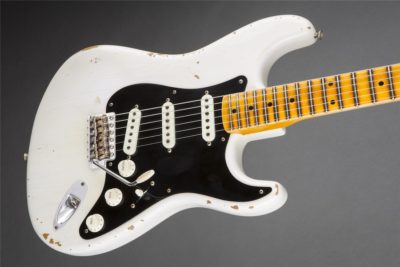
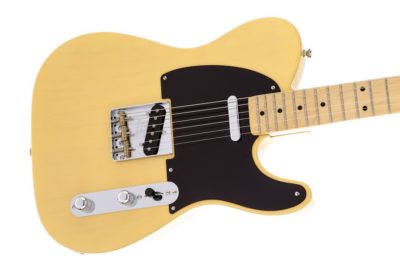

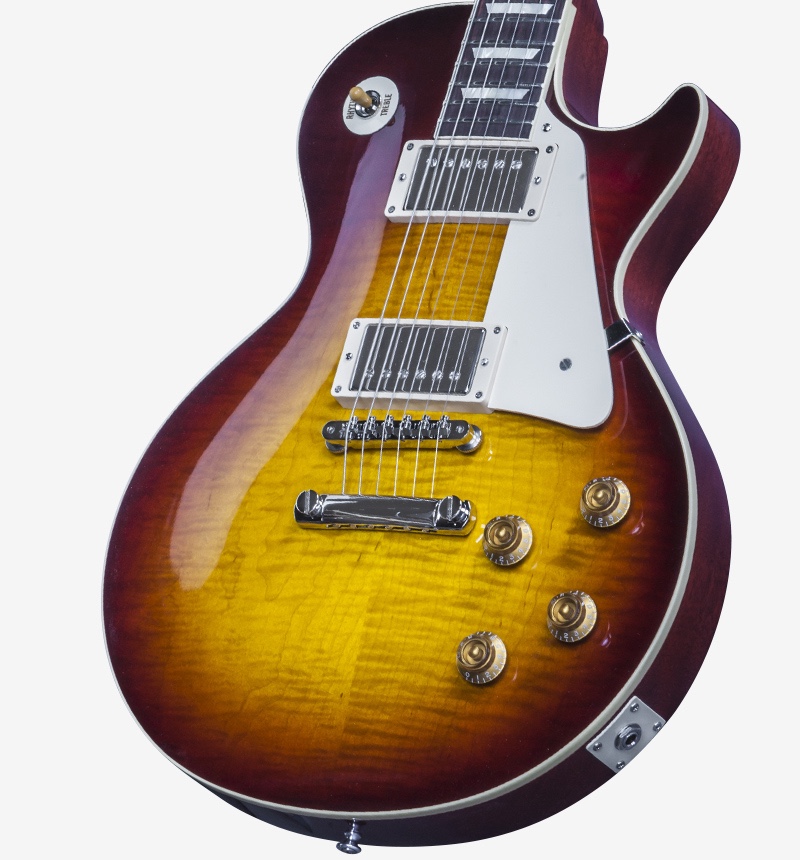
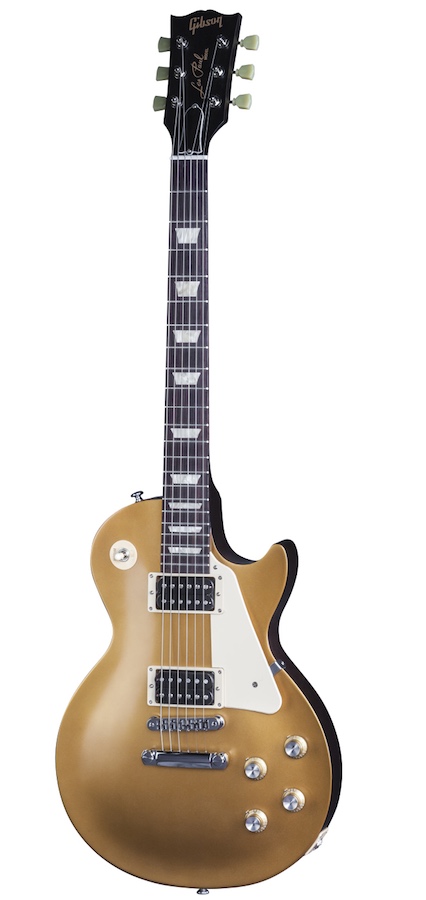
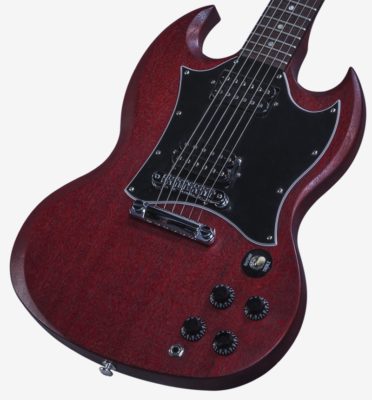
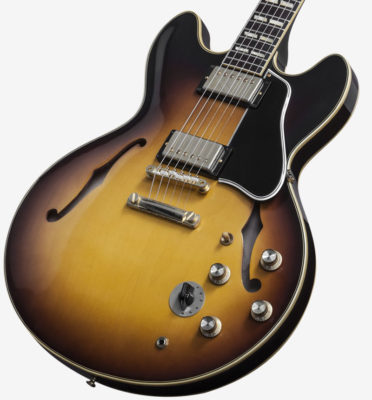
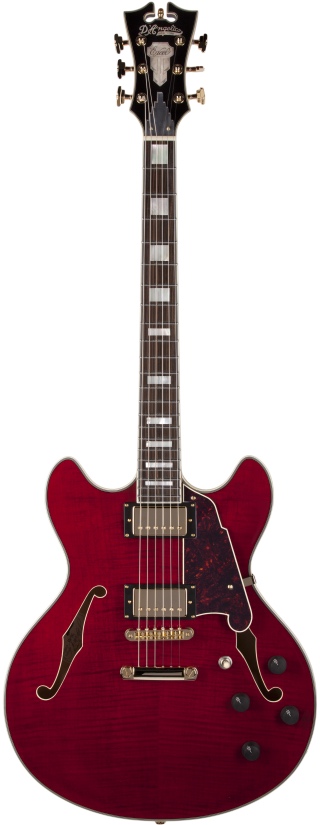
roscoenyc
June 9, 2016 at 3:34 pm (8 years ago)I disagree. Most players have this stuff. What you need on hand at a studio are things players may not have or have with them. An electric 12 string guitar, a Baritone guitar, a guitar with a Bigsby on it and a couple of really good acoustics. One of them in high string tuning.
Hakeem
June 13, 2016 at 7:38 am (8 years ago)Yeah, make an ice cream shop that sells vanilla and chocolate. People will be camping outside waiting for business to open…
Michael Murray
December 31, 2016 at 12:58 pm (7 years ago)I’d also recommend Dan Strain’s guitars — he makes them in his home shop in Nashville, and they’re very highly-regarded/ not crazy-expensive: http://danocaster.com/
Also agree with roscoenyc about electric 12-string (I have a restored old Ricky 12-string) etc.
Knuckles Mutatis
February 19, 2017 at 1:03 pm (7 years ago)Quote: “Jimmy Page is known for playing Les Pauls on stage, but he used a Telecaster a lot back when he was primarily a session guitarist, as well as on some classic Led Zeppelin recordings like “Communication Breakdown” and “How Many More Times.”
It’s more than that. He used a Telecaster on *every* song on Led Zeppelin 1 other than “You Shook Me” (Flying V). He also used a Telecaster for the solo for “Stairway to Heaven”, as well as “All of My Love”, “Hot Dog”, and probably some other songs I’m missing.
Justin C.
February 23, 2017 at 10:34 am (7 years ago)Hey Roscoe,
I agree with both of you! This roundup is meant to set the baseline for having a useful studio guitar for everyday use. (Especially when the band’s guitars are less than ideal, which often happens, especially with younger artists.)
That said, YES: Definitely agreed that some of these less common guitars are a great add to any studio, and that most artists aren’t going to have access to them otherwise. We actually have a story like that planned for the future.
Great additions here, thanks!
Justin C.
February 23, 2017 at 10:38 am (7 years ago)That is true—it was a Tele on every song on Zeppelin 1. Matthew’s wording here is technically still accurate, but you are right about all of that, and it is great context to add.
I wish I had made that recommendation myself while doing an editing pass. But Matthew’s wording is still right (and very concise.) It just leaves out some very worthwhile details. Thanks for adding them here!